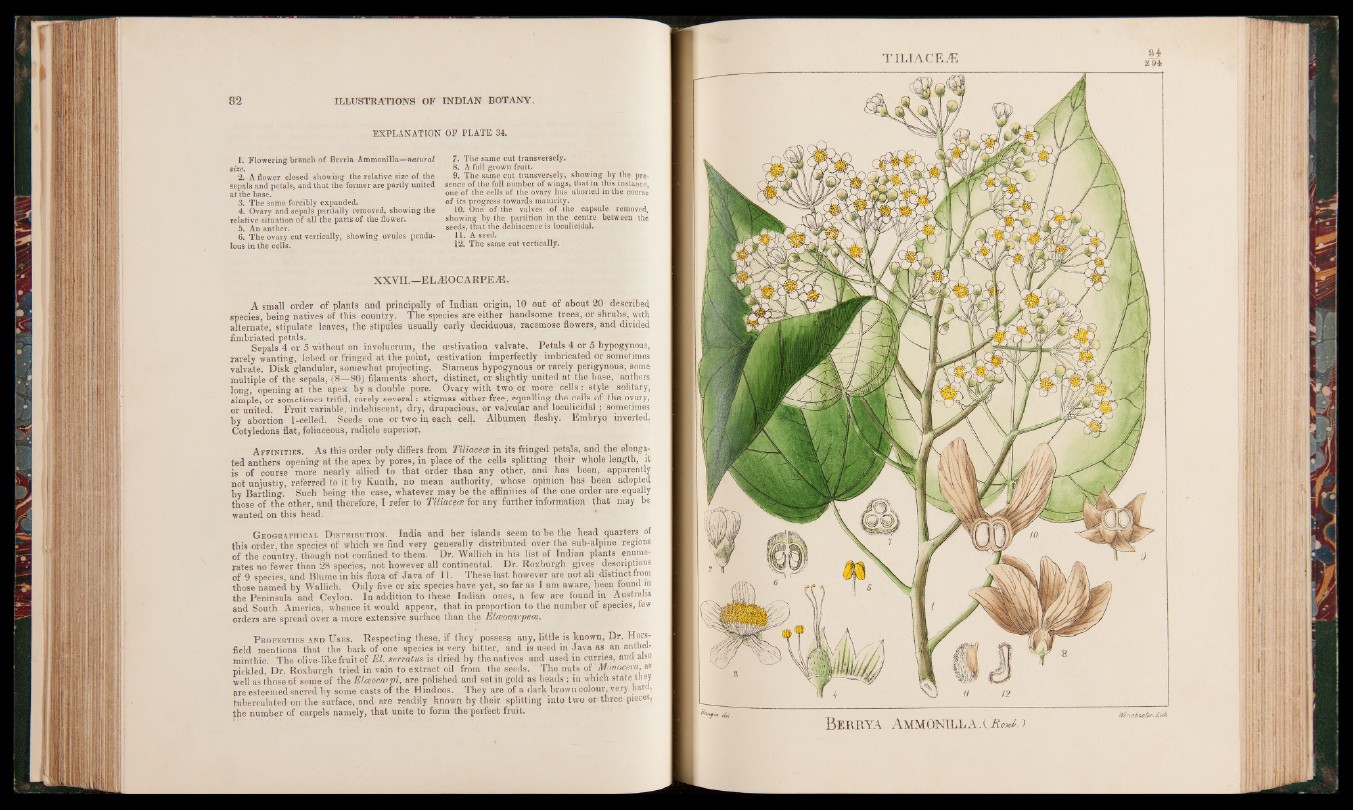
EXPLANATION OP PLATE 34.
1:. Flowering branch of Berria Ammonilla—natural
size.
2. A flower closed showing the relative size of the
sepals and petals, and that the former are partly united
at the base.
3. The same forcibly expanded.
4. Ovary and sepals partially removed, showing the
relative situation of all the parts of the flower.
5. An anther.
6. The ovary cut vertically, showing ovules pendulous
in the cells.
7. The same cut transversely.
8. A full grown fruit.
9. The same cut transversely, showing by the presence
of the full number of wings, that in this instance,
one of the cells of the ovary has aborted in the course
of its progress towards maturity.
10. One of the valves of the capsule removed,
showing by the partition in the centre between the
seeds, that the dehiscence is loculicidal.
11. A seed.
12. The same cut vertically.
XXVIL—ELÆOCARPEÆ,
A small order of plants and principally of Indian origin, 10 out of about 20 described
species, being natives of this country. The species are either handsome trees', or shrubs, with
alternate, stipulate leaves, the stipules usually early deeiduous, racemose flowers, and divided
fimbriated petals.
Sepals 4 or 5 without an involucrum, the eestivation valvate. Petals 4 or 5 hypogynous,
rarely wanting, lobed or fringed at the point, oestivation imperfectly imbricated or sometimes
valvate. Disk glandular, somewhat projecting. Stamens hypogynous or rarely perigynous, some
multiple of the sepals, (8—80) filaments short, distinct, or slightly united at the base, anthers
long, opening at the apex by a double pore. Ovary with two. or more cells : style solitary,
simple, or sometimes trifid, rarely several : stigmas either free, equalling the cells of the ovary,
or united. Fruit variable, indéhiscent, dry, drupacious, or valvular and loculicidal ; sometimes
by abortion 1-celled. Seeds one or two in each cell, Albumen fleshy. Embryo, inverted.
Cotyledons flat, foliaceous, radjelg superior,
A f fix itibs. A s this order only differs from Tiliaçeæ in its fringed petals, and the elongated
anthers opening at the apex by pores, in place of the cells splitting their whole length, it
is of course more nearly allied to that order than any other, and has been, apparently
not unjustly, referred to it by Kunth, no mean authority, whose opinion has been adopted
by Bartling. Such being the case, whatever may be the affinities of the one order are equally
those of the other, and therefore, I refer to Tiliaçeæ for any further information that may be
wanted on this head.
G eographical D istr ibu t io n . India and her islands seem to be the head quarters of
this order, the species of which we find very generally distributed over the sub-alpine regions
of the country, though not confined to them. Dr. Wallich in his list of Indian plants .enumerates
no fewer than 28 species, not however all continental. Dr. Roxburgh gives descriptions
of 9 species, and Blume in his flora of Java of 11. These last however are not all distinct from
those named by Wallich. Only five or six species have yet, so far as I am avyare, been found in
the Peninsula and Ceylon. In addition to these Indian ones, a few are found in Australia
and South America, whence it would appear, that in proportion to the number of species, few
orders are spread over a more extensjve surface than the Elæoc/irpeæ..
P roperties anp U ses. Respecting these, if they possess any, little is known, Dr. Hors-
field mentions that the bark of one species is very bitter, and is used in Java as an anthelminthic.
The olive-like fruit of El. serratus is dried by the natives and used in curries, and also
pickled, Dr. Roxburgh tried in vain to extract oil from the seeds. " The nuts of ‘Monocera, as
well as those of some of the Élæocarpi, are polished and set in gold as beads ; in which state they
pre esteemed sacred by some casts of the Hindoos. They are of a dark brown colour, very hard,
tuberculated on the surface, and are readily known by their splitting into two or three piçees,
the number of carpels namely, that unite to form the perfect fruit. Berrya Ammonill
84
2 9 4